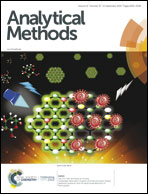Discrimination of papers used in conservation and restoration by the means of the voltammetry of immobilized microparticles technique
Abstract
Herein, voltammetry of immobilized microparticles (VIMP) is employed for the discrimination of papers used in the conservation and restoration field. The electrochemical parameters are used for the discrimination of different samples coming from China, Japan and Korea. The method is based on the recording of the voltammetric response of microparticulate deposits from acetone extracts of paper samples deposited on a glassy carbon electrode in contact with 1.0 M H2SO4. The voltammetric responses attributed to the lignin and the oxidation products of the cellulose were collected and are discussed. The grouping of samples was obtained upon the application of the chemometric methods, as well as the ratio between the prominent voltammetric peaks. In the first case, chemometrics allows identification of the different papermaker production techniques amongst the samples, while the experimental data permits the grouping of the papers according to their internal chemical differences. The proposed method aims at help the archaeometric study of papers using a micro-invasive method, which allows the chemistry and the manufacturing methods of ancient papers to be distinguished.



 Please wait while we load your content...
Please wait while we load your content...